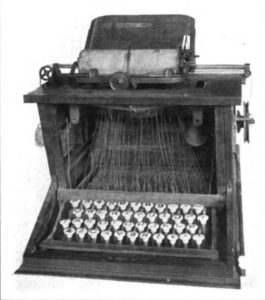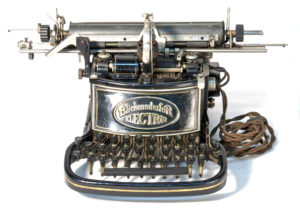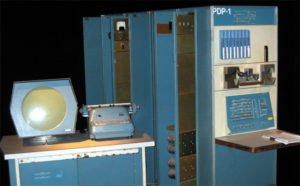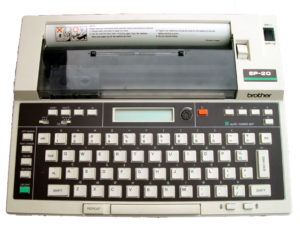Word processor software has become an indispensable tool in our daily life. Remarkably, this software product appears to have evolved from the mechanical typewriter. This article is the first of a series of four on product evolution. They illustrate how technological evolution can explain ‘the origin of products’. Obviously, this type of evolution is different from what we are used to with biological species.
Mechanical

Writing is recognised as one of mankind’s foremost inventions and the mechanization of writing is one of these developments that typify what is commonly regarded as the work of genius inventors. However, the typewriter was not ‘suddenly invented’, but emerged from the work of many inventors who all contributed inventive steps. In 1714 the English inventor Henry Mill patented a “machine for transcribing letters”. The industrial revolution that started some decades later provided a wide variety of manufacturing technologies that have supported the conception of many new types of useful products. From the beginning of the 19th century onwards there was an increase in inventive activities that led to the creation of the typewriter and these quickly provided the many small inventive steps that make up a leap. One of the many inventors working on a device to mechanise writing was Christopher Latham Sholes who, together with Glidden and Soule, patented a typewriter in 1868. After many improvements this led to a first typewriter with a QWERTY-based keyboard. Remington in the USA started manufacturing this typewriter in 1873. With this device the mechanisation of writing really took off.
The typewriter was not ‘suddenly invented’, but emerged from the work of many inventors who all contributed inventive steps
The typewriter was developed on the basis of the promise that its operator would write faster and more clearly than was possible by hand. This gave the typewriter economic potential. Of course, one first had to go through a learning curve to master the keyboard and, as later transpired, that learning curve provided the reason why we still use the same layout. Mastering one type of keyboard requires time and effort, which goes to waste if you start using a different type. Hence, once a particular standard has been learned, people tend to stick to it and the more people use it, the more valuable it becomes. This self-reinforcing effect meant that QWERTY became the de facto standard typewriter keyboard layout and is now locked in to our capability set. Versions other than QWERTY have been developed to accommodate particular languages. The French use AZERTY and Germans use QWERTZ. For these layouts the same applies, namely that once people are used to it, they tend to stick to it. And for a reason. Just try a version you are not used to and you will quickly discover how confusing it is being lost on a keyboard.
The typewriter proliferated after the mid-1880s and soon it became an indispensable tool, particularly for business correspondence. New job types like secretary and telephone operator created opportunities for women to work beyond the confines of the home. The typewriter and its contemporary telephone became the secretary’s standard tools. Without answering the question of whether the typewriter and the telephone are a cause or an effect of social change, it is evident that the new technologies played a significant role in the liberation of women.
The typewriter soon it became an indispensable business tool and, together with the telephone, played a significant role in the liberation of women
Electrical

The early day typewriters were quite cumbersome devices to use because of what was described as the hammer and peck method. This spurred inventors to look for solutions to overcome this problem in an attempt to provide ‘new and improved’ products. One of the solutions developed for the mechanical typewriter became known as touch-typing. Another solution to reduce the amount of force required to operate the mechanical typewriter was found in using electric power, a technology that was still in its infancy at the beginning of the 20th century. The Blickensderfer Electric was introduced to the world at the Pan-American Exhibition in Buffalo as long ago as 1901. This first electric typewriter was ahead of its time. Indeed, it was so far ahead that electric power transmission had not even been standardized yet. The fact that voltages changed from one town to the next was a likely reason for its commercial failure. As electrification continued to develop, standards were set and the environment became receptive to electric typewriters. As a result numerous variants were developed and manufactured in the following decades.
The International Business Machines Corporation, better known as IBM, was one of the many companies active in the development and manufacturing of office equipment. IBM became very successful with is Selectric line of electric typewriters. The first Selectric was introduced in 1961. Various models appeared on the market until IBM introduced a successor in 1984. The Selectric featured a ‘typeball’ instead of many separate typebars. This made it possible to change fonts and therefore increased the functionality of this particular machine. Remarkably, the first Blickensderfers had also featured a cylindrical typewheel which provided similar benefits to IBM’s typeball. Unfortunately for Blickensderfer their typewheel was short-lived. This shows that it takes more than a good idea to be successful. Circumstances need to be favourable as well.
It takes more than a good idea to be successful, circumstances need to be favourable as well
Electronic

Once the electric typewriters had gained ground, and the first computers had been produced, inventors started combining the two. One of the first experiments in this field is the Colossal Typewriter introduced in 1960, which became known as one of the first text editors. It required an electric typewriter as input means, a display and a ‘computer’ like the Programmed Data Processor-1 which, as was common in those days, still had the size and looks of an office storage cabinet. In any event, the primordial word processor had been born. In the 1970s, more compact electronic versions of the typewriter gained ground. The New York Times reports in 1971 that ‘word processing’ was the ‘buzz word’ of a business equipment tradeshow. According to manufacturers presenting at the show, it would ‘replace the traditional secretary and give women new administrative roles in business and industry’.
In the years that followed, the electronic typewriter became a more common phenomenon in the workplace.
Electronic typewriters enhanced with embedded software became known as word processors

One example of those machines is the Brother EP-20, which was introduced in 1983. This electronic typewriter featured a small dot matrix display on which typed text appeared. It also included a memory that allowed text to be stored and corrected where necessary. These electronic typewriters enhanced with embedded software became known as word processors. The use of a new name like this is typical for the emergence of a new type of product with new functionality well beyond that of its predecessor.
Software
Evolutionary pressures ensured that these early word processors soon received competition. The reason for this was the development of microcomputers in the 1970s that were introduced to fill niches that the mainframe computers of that age could not serve. Microcomputers were followed by home computers, which eventually became known as personal computers or PCs. As a result of on-going miniaturization of microprocessors, the brains of these machines, PCs rapidly became more powerful.
The availability of these new small computers, displays and matrix printers made it possible to develop software applications for PCs that provided word processor functionality. With the advent of more software and stronger microprocessors, these PCs became more versatile and swiftly became commonplace throughout the business world. As a result the functionality first provided by electronic typewriters now shifted towards a software application on the PC and the digitalization of writing took off. Being a software application allowed the new word processor to evolve much faster than its ancestor that was trapped in a typewriter. As a result this functional shift signalled the end of the relevance of both the mechanical and electric typewriter. The keyboard, however, survived and separated to become a new type of product in its own right. QWERTY and its variants still thrive today in these keyboards and their touch screen cousins.
Functionality first provided by electronic typewriters now shifted towards a software application on the PC
Word processor software became the one of the first popular applications on the PC and hugely improved office productivity. In 1971 a third of all working women in the USA were secretaries. The job type of secretary was closely linked to the existence of the typewriter. As few managers of that time acquired typing skills, the typist fulfilled an essential role in offices. However, the advent of word processors that not only allowed text to be corrected but also supported it with spellchecker functionality meant that users only needed minimal typing skills. This too slowly but surely reduced the demand for typists.
The usage of word processor software rapidly increased, with lots of different designs and vendors competing. In around 1980 dozens of software brands were selling word processor software. WordStar became the first market leader in 1979, a role that was taken over by WordPerfect in 1985. In 1986 PC Magazine featured a review comparing a stunning total of no fewer than 57 different word processor software brands. This was clearly the heyday of word processor software. Incremental features were added such as multiple font sets, spell checking, grammar checking, thesaurus, formatting options and different formats to save text. WordPerfect used a text mark-up method not very unlike HTML code. The 5.1 release from WordPerfect featured a print preview mode showing text without the mark-up code. At the time the print preview mode was referred to as WYSIWYG (what you see is what you get), a quite unique feature at a time that the graphical interface was not yet standard.

Over the years more and more features were introduced into word processor software, further advancing the productivity of its users. These include collaborative editing, table of content formatting, version control and document statistics.
More and more features were introduced into word processor software, further advancing the productivity of its users
Together with the advance of the PC and word processor software, printers also become more affordable. In particular, the spread of laser and inkjet printers allowed users to print sharp and versatile fonts. This led to the decline of the typewriter. Although typewriters have not disappeared completely, they have lost their significance. The introduction of retro models functioning only as computer keyboards underlines their status as museum pieces.
Future outlook
Professionals like lawyers, doctors and translators have used software that converts spoken word into written text to increase their productivity for some years now. Recently, artificial intelligence (AI) entered the domain of writing and enabled a functionality named ‘predictive text input’. A software application ‘learns’ from previous texts and uses neural networks to predict which next word a writer is working on. This application first appeared on smartphones where it is particularly useful as the small screens leave little room for full size keyboards. Using this application can both hugely increase speed or productivity and produce strange sentences. Users have to be wary and check what has been entered before sending messages. An example of this software is SwiftKey. The company started operating in 2008 and was acquired by Microsoft in 2016. This makes one wonder whether predictive text input might soon feature in word processor software. Whatever Microsoft’s intentions are with the acquisition of this predictive text input software, there is no reason to expect that the evolution of writing will stop there. As AI is the big new thing, it seems fair to assume that it will somehow affect the further evolution of writing. It is only a matter of time before a new name and a new type of (software) product will surely emerge.

It seems fair to assume that AI will somehow affect the further evolution of writing
Conclusion
The word processor did not simply come from nowhere. It originated from a series of innovations that improved writing productivity. The original mechanical typewriter was an important ancestor in its line of origin. The typewriter evolved further, while making good use of technologies that were originally developed for other purposes. Over the period of a century many intermediate products evolved and, without this being pre-planned, paved the way, step-by-step, for the word processor.
Just as in speciation of natural organisms, the environment played a crucial role in the evolution of the word processor. Social economic developments like women’s liberation went hand in hand with the advent of new products like the typewriter and telephone. Later, the advent of the personal computer and, in its wake, the word processor again changed the labour market. The office environment in which many people work thus affected the emergence and evolution of these products. This environment appears to be part and parcel of the evolution of both the typewriter and the word processor.
Copyright © 2018 Huub Ehlhardt. All Rights Reserved. Please contact us for re-use of this article.
The book ‘On the Origin of Products’ is available via Cambridge University Press, Bol.com and Amazon. This site also provides an introduction to this title.


Thanks for this article! Very informative.
very informative.
Very informative